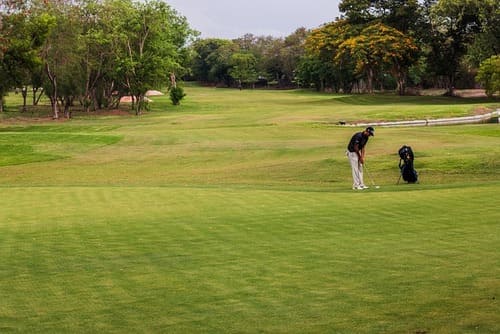The term “mulligan” is deeply woven into the fabric of golf culture, yet its origins remain shrouded in mystery. Historians and etymologists have attempted to trace the roots of this golf term, but definitive answers have proven elusive. Despite the lack of concrete evidence, several theories have emerged, offering various explanations for the elusive origins of the mulligan.
One prevailing theory suggests that the term originated from a man named David Bernard Mulligan. A golfer from Montreal with a notorious reputation for his habit of retaking shots. According to this theory, Mulligan and his golfing companions would jokingly refer to the act of taking a second shot as a “Mulligan.”
Over time, the term caught on and became widely used in golfing circles. However, this theory lacks solid historical evidence, leaving the true beginnings of the mulligan still enveloped in uncertainty.
Another theory proposes that the term harks back to the early 1900s. The story goes that a Canadian hotelier hosted a group of golfers in Quebec. One of the players, Colonel Mulligan, typically struggled with his opening tee shot. On one occasion, the generous hotelier allowed Mulligan to retake his shot. Thus coining the phrase “a Mulligan” for the act of taking a do-over.
Like the previous theory, this explanation lacks verifiable evidence. Golf enthusiasts have been left with an unsolved mystery at the heart of their beloved game.
The Official And Unofficial Rules Of Mulligans
When it comes to mulligans, understanding the rules is essential for any golfer. The official rule states that a mulligan can only be taken on the first tee shot of the round. If you miss the fairway or are unhappy with your shot, you can choose to hit again without penalty. However, it is crucial to note that this rule varies depending on the golf course and the specific tournament or casual round being played.

Some courses may allow mulligans on other shots during the round, while others strictly adhere to the traditional rule. Moreover, in competitive play, mulligans are generally not permitted and considered a breach of etiquette. It is important to familiarize oneself with the specific rules of the golf course or tournament before deciding to take a mulligan.
In addition to the official rules, there are also numerous unofficial rules that govern the use of mulligans. Firstly, it is customary for golfers to limit their mulligans to one per round. Multiple mulligans can be seen as disprespectful or disruptive to the pace of play, especially in a crowded course.
Secondly, it is customary to announce your intention to take a mulligan before hitting the shot. This allows your playing partners to witness the mulligan and avoid confusion or misunderstanding.
Lastly, if you choose to take a mulligan, it is important to play it as honestly as possible. This means taking the same stance, using the same club, and aiming for the same target as your original shot would have intended. Any intentional adjustments or attempts to gain an unfair advantage are frowned upon and against the spirit of the game.
Exploring The Dos And Don’ts Of Taking A Mulligan On The Golf Course
Taking a mulligan on the golf course is a common occurrence. But it is important to understand the proper etiquette surrounding this practice. One of the key dos of taking a mulligan is to always ask for permission from your playing partners before rehitting a shot.
It is considered polite to seek their approval, as it shows respect for the other golfers and their playing experience. Additionally, when taking a mulligan, it is crucial to be mindful of the pace of play. Remember that other groups may be waiting behind you, so take your mulligan efficiently and keep the game moving smoothly.
On the other hand, there are some important don’ts to keep in mind when it comes to mulligan etiquette. Firstly, it is generally frowned upon to take a mulligan during a tournament or competitive round. However, some tornaments allow mulligans by the rules of the event. Mulligans are generally seen as part of casual play. So it’s best to adhere to the official rules in more formal settings.
Moreover, it is not considered appropriate to take multiple mulligans on a single hole or throughout the round. The purpose of a mulligan is to give yourself a second chance when you make a mistake, not to repeatedly redo shots until you achieve the desired result.
A Beginner’s Guide To Understanding When And How To Use A Mulligan
When it comes to golf, understanding the concept of a mulligan is crucial for beginners. A mulligan, commonly known as a “do-over” or a “free shot,” is essentially an opportunity to erase a poor shot and try again. It’s important to note that mulligans are not an official rule in golf, but rather a courtesy extended by fellow players.
The rules may vary depending on the course and the players involved. Although, it is generally accepted that mulligans are used to provide a beginner with a second chance. This is to promote a more enjoyable and less frustrating experience on the course.
Determining when to use a mulligan can be a bit tricky for beginners. The general rule of thumb is to use a mulligan when you feel that your initial shot was exceptionally poor or when you feel that you did not have a fair opportunity to hit the ball correctly. However, it is important to use mulligans responsibly and in moderation, as constantly taking do-overs can disrupt the pace of play for your group.
Additionally, keep in mind that mulligans are not meant to be used to improve your game by repeating shots until you achieve the desired result. Rather, they are intended to provide a beginner with some relief from the pressures of the game and make the experience more enjoyable.
How Skilled Golfers Strategically Utilize Mulligans To Improve Their Game
Golf is a game that requires players to strategize and make calculated decisions to achieve their desired outcomes. Skilled golfers understand the importance of utilizing mulligans strategically to improve their game. A mulligan, or a do-over shot, can be a valuable asset when used at the right moment.
One strategy that skilled golfers employ is reserving their mulligans for crucial shots that could potentially impact their overall score. They carefully assess the situation, considering factors such as distance to the hole, wind direction, and positioning on the fairway.
By doing so, they can determine when using a mulligan can offer them a better chance of achieving their desired outcome. Whether it’s avoiding a bunker, navigating a water hazard, or making a precise approach shot. The ability to make strategic decisions regarding when to use a mulligan is crucial for improving a golfer’s overall performance on the course.
Skilled golfers also understand the importance of mental resilience when utilizing mulligans. Instead of viewing a mulligan as a way to correct a mistake. They see it more as an opportunity to reset and refocus. By adopting this mindset, golfers can alleviate any frustration or disappointment arising from a less-than-ideal shot and approach subsequent shots with a clear and positive mindset.
This mental fortitude allows them to make the most out of their mulligan. Thus maximizing its potential in improving their game.
Exploring Different Types Of Mulligans And Their Impact On The Game
One popular variation of the mulligan is known as the “lunch ball” mulligan. This type of mulligan allows players to hit a second shot without penalty if their first shot goes out of bounds or into a hazard. It is a more lenient version of the traditional mulligan and is often used in casual rounds with friends or during charity events.

The lunch ball mulligan provides players with an opportunity to recover from a poor shot and continue their round without the added stroke on their scorecard.
Another variation of the mulligan in golf is the “second-chance” mulligan. This type of mulligan allows players to re-hit a shot that they feel did not properly represent their skill or ability. It is often used when a player feels they were distracted or rushed during their initial shot.
The second-chance mulligan is more subjective in nature and is typically used in friendly, non-competitive rounds. Although it may not be recognized as an official rule. It allows players to maintain the integrity of their game and ensure a fair outcome.
Famous Mulligan Moments
One famous Mulligan moment that will forever be etched in golf history is the 2011 Masters Tournament. At the 15th hole, Tiger Woods found himself in a troublesome position after hitting his tee shot into the trees. Faced with a difficult recovery shot, Tiger decided to exercise his Mulligan privilege and re-hit his shot.
This Mulligan proved to be a game-changer as he made an incredible recovery. His ball landing just feet from the hole. The crowd erupted in applause, and Tiger went on to secure a birdie. This propelled him to win the tournament, adding another chapter to his legendary career.
Another iconic moment involving a Mulligan occurred during the 2019 U.S. Open. On the 18th hole, Gary Woodland, locked in a tight battle with Brooks Koepka, hit his tee shot into the rough. Rather than accepting his fate, Woodland confidently announced that he would be taking a Mulligan. With all eyes on him, he expertly hit his second tee shot, this time finding the fairway.
This Mulligan allowed Woodland to approach the green with precision, setting up a crucial par-saving putt to secure his first major victory. His bold use of the Mulligan showcased his ability to seize opportunities and highlighted the impact that a second chance can have on the outcome of a tournament.
Mulligan Controversies
The use of mulligans in competitive play has long been a subject of debate among golf enthusiasts. Detractors argue that allowing players to take a second shot after a poor initial attempt goes against the fairness and integrity of the game. They argue that golf is a sport that tests a player’s skill. Taking a mulligan undermines this aspect by giving players a chance to erase their mistakes.

On the other hand, proponents of mulligans believe that they add an element of enjoyment to the game, particularly for amateur players. They argue that mulligans allow players to shake off the pressure and frustration that often come with a bad shot, leading to a more relaxed and enjoyable experience on the golf course.
Another point of contention surrounding the use of mulligans in competitive play is the question of when exactly they should be allowed. Some argue that mulligans should only be used sparingly and in specific situations. Such as during friendly matches or practice rounds. They believe that using mulligans too often or in high-stakes competitions undermines the integrity of the game and creates an unfair advantage for certain players.
On the other hand, others argue that mulligans should be allowed more freely, even in official tournaments. They argue that golf is ultimately a game meant for enjoyment. Only if allowing mulligans enhances the experience for players, then there should be no restrictions on their use. Ultimately, the debates surrounding the use of mulligans in competitive play reflect the ongoing tension between tradition and innovation in the world of golf.
Mulligan Stories: Sharing personal anecdotes and experiences related to mulligans on the golf course
Anecdote 1:
During a friendly round of golf with my buddies, I found myself in a rather precarious situation. My ball had ended up in the rough, and the pressure was on to make a good shot. Feeling the weight of my friends’ expectant gazes, I decided to take a mulligan.
As luck would have it, my second attempt sailed gracefully through the air and landed neatly on the green. The sense of relief and accomplishment was palpable, and we all celebrated my lucky escape from a potentially disastrous hole. It was a reminder of the joy and camaraderie that can be found on the golf course, even in the face of adversity.
Anecdote 2:
On another occasion, while playing in a local tournament, I witnessed a rather amusing mulligan moment. One of the players teed off with great enthusiasm, only to watch in horror as their ball veered off wildly to the left, ultimately ending up in a water hazard. Displaying quick thinking and a dash of creativity, the golfer decided to embrace the mulligan spirit.
With a sly grin, they dropped another ball and took another swing, this time sending it high and straight down the fairway. The gallery erupted into laughter and applause, appreciating the player’s ability to laugh off a less-than-ideal first shot. It was a true testament to the forgiving nature of mulligans and the lightheartedness they can bring to the game.
Tips and techniques to make the most out of your mulligan opportunities
When it comes to mastering the mulligan in golf, there are a few key tips and techniques that can significantly enhance your chances of making the most out of this valuable opportunity.
First and foremost, it’s important to remember that a mulligan should be used sparingly and strategically. It’s not a free pass to redo every shot that doesn’t go as planned. Instead, reserve your mulligan for those truly crucial moments. Especially when the pressure is on and a successful shot could make all the difference.
By being selective with your mulligans, you can maximize your chances of improving your score and overall performance on the golf course.
Furthermore, it’s essential to approach your mulligan with a clear and calm mindset. While it’s tempting to feel frustrated or disappointed after a poor shot, letting negative emotions cloud your judgment will only hinder your ability to take advantage of the mulligan.
Instead, take a deep breath, assess the situation, and visualize the shot you want to make. By focusing on the desired outcome and maintaining a positive mindset, you increase your chances of executing a successful shot with your mulligan.
Remember, the power of visualization and mental preparation should not be underestimated in the quest to master the mulligan.





